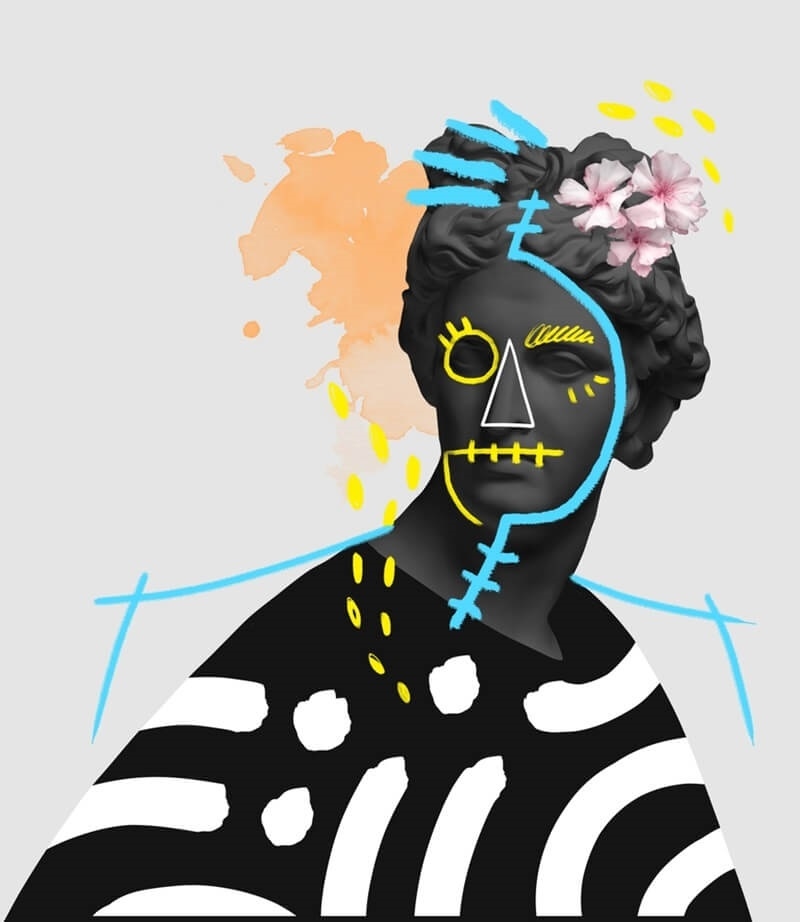
Picture this: A frazzled college student named Jake stumbles into a modern art gallery to kill time before his dentist appointment. He’s staring at a Warhol-esque print of a Campbell’s soup can—except this one looks like it’s melting into a neon lava lamp. “Is this a printer error?” he whispers. Nearby, a silver-haired curator smirks. “Nope, kid. That’s abstract Pop Art. And it’s been messing with perceptions since the ’60s.”
Turns out, Jake’s confusion is the whole point. Abstract modern Pop Art isn’t just about slapping comic book colors on celebrity faces. It’s a rebellious mashup—think Andy Warhol and Jackson Pollock sharing a chaotic espresso—where consumer culture collides with emotional abstraction. Let’s unpack how this genre became the ultimate “rule-breaker” of the art world.
Pop Art’s origins are as bold as a Roy Lichtenstein comic panel: It exploded in the ’50s as a middle finger to elitist art, celebrating soda bottles, movie stars, and everything “unserious.” But here’s the twist—abstract expressionism was the moody, introspective cousin dominating galleries at the time. Artists like Willem de Kooning splattered emotions onto canvases, while Warhol screen-printed . Polar opposites, right?
Wrong. By the late ’60s, creators started asking: “What if we merge Marilyn Monroe’s face with paint-slinging chaos?” The result? Pop Art abstract expressionism—a genre that’s equal parts supermarket tabloid and existential crisis. Imagine a Warhol flower print blurred into a storm of brushstrokes, or a comic book heroine dissolving into ink blots. It’s art’s version of a jazz improv session: structured yet wildly unpredictable.

Let’s get real for a sec: Pop Art techniques weren’t just about tracing cartoons. The magic happened when artists hijacked commercial aesthetics and abstracted them into something raw. Here’s how they did it:
Pro Tip: Next time you see a Lichtenstein piece, squint. Those Ben-Day dots aren’t just comic book throwbacks—they’re optical illusions creating movement, like a GIF trapped in paint.
Spoiler: Critics HATED this fusion at first. “It’s like putting a whoopee cushion on the Mona Lisa!” huffed one 1972 review. But abstract pop art artists thrived on the controversy. Take Rosalyn Drexler, whose ’60s paintings mashed wrestling posters with jagged abstract shapes. Was it a commentary on violence as entertainment? A feminist jab at macho culture? Drexler shrugged: “Why not both?”
Then there’s Peter Saul, the prankster prince of the movement. His 1985 piece “Icebox Number 8” features a fridge stuffed with grotesque, melting food—a grotesque twist on consumerism that feels like a grocery store nightmare. “I wanted it to look like your brain after watching too many TV commercials,” he quipped.
Scroll TikTok lately? There’s a viral trend where users film their grandma’s reaction to abstract modern Pop Art (“Is that a hot dog or a UFO?!”). Meanwhile, streetwear brands slap Warhol-meets-Pollock designs on hoodies, and Instagrammers stage photoshoots in front of giant Keith Haring murals that’ve been “glitched” into abstraction.
But here’s the thing: This isn’t just nostalgia. A 2023 MoMA study found Gen Z resonates with Pop Art abstract expressionism because it mirrors their digital lives—constant noise, fragmented attention, beauty in the chaos. Ever felt hypnotized by a TikTok feed? That’s the same dizzy thrill of a Rosenquist painting.
Want to channel your inner Warhol-Pollock lovechild? Grab these supplies:
Now:
“But I can’t even draw stick figures!” Relax. The genre thrives on “happy accidents.” Corita Kent, the nun-turned-abstract pop art artist, famously said her best work happened when silk screens malfunctioned.
Read More: How Social Media Boosts the Popularity of Modern Pop Art
Standing confused in front of a James Rosenquist mural? Try this:
Still lost? Channel 80-year-old Doris from Ohio, who muttered at a 2024 exhibition: “This looks like my garage sale pile… but I kinda love it?”
Move over, Warhol. Let’s spotlight rebels who blurred the lines first:
Fun Fact: Many female abstract pop art artists were sidelined as “eccentric” until TikTok rediscovered them as #ArtMoms.
Let’s address the elephant in the gallery: NFTs. Digital artists like Blake Kathryn now create abstract modern Pop Art with 3D glitches and holographic textures. Love it or hate it, it’s resurrecting the movement’s punk spirit.
Meanwhile, traditionalists like Jonas Wood are blending basketball memorabilia with jagged abstract shapes—proving the genre’s still a cultural mirror.
You will see abstract Pop Art splashed over metropolitan streets outside the white walls of museums. Murals in Brooklyn, Berlin, and São Paulo remix Warhol's silk screens with rebellious spray-painted drips, so demonstrating that this movement is a live, breathing force rather than only a remnant of the '60s.
Retna and KAWS are among street artists who bridge past and present by distorting commercial images into enigmatic messages. Abstract Pop Art lives where anarchy meets culture, on a crumbling brick wall or a sweatshirt. One neon explosion at a time, it belongs to the public not only for collectors.
Here’s your homework:
That gritty mix of commercialism and raw feeling? That’s Pop Art abstract expressionism in the wild.
Read More: Learn How to Incorporate Pop Art Styles in Contemporary Art
Abstract Pop Art isn’t about answers—it’s about questions. Can a soup can make you cry? Should a cartoon character’s tears look like oil spills? By fusing the familiar with the abstract, this genre holds up a funhouse mirror to our consumerist souls. And honestly? In a world of AI filters and deepfakes, we could use more art that keeps us deliciously unbalanced.
So next time you see a “printer error” painting, channel Jake from the gallery: Lean in, squint, and let the chaos click. Who knows? That melting soup can might just melt your preconceptions too.
This content was created by AI